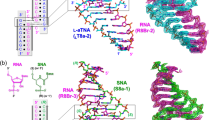Abstract
ALTHOUGH the importance of the nucleobases in the DNA double helix is well understood, the evolutionary significance of the deoxyribose phosphate backbone and the contribution of this chemical entity to the overall helical structure and stability of the double helix is not so clear. Peptide nucleic acid (PNA)1–7 is a DNA analogue with a backbone consisting of N-(2-aminoethyl)glycine units (Fig. 1) which has been shown to mimic DNA in forming Watson–Crick complementary duplexes with normal DNA7. Using circular dichroism spectroscopy we show here that two complementary PNA strands can hybridize to one another to form a helical duplex. There is a seeding of preferred chirality which is induced by the presence of an L- (or D-) lysine residue attached at the carboxy terminus of the PNA strand. These results indicate that a (deoxy)ribose phosphate backbone is not an essential requirement for the formation of double helical DNA-like structures in solution.
This is a preview of subscription content, access via your institution
Access options
Subscribe to this journal
Receive 51 print issues and online access
$199.00 per year
only $3.90 per issue
Buy this article
- Purchase on Springer Link
- Instant access to full article PDF
Prices may be subject to local taxes which are calculated during checkout
Similar content being viewed by others
References
Nielsen, P. E., Egholm, M., Berg, R. H. & Buchardt, O. Science 254, 1497–1500 (1991).
Egholm, M., Buchardt, O., Nielsen, P. E. & Berg, R. H. J. Am. chem. Soc. 144, 1895–1897 (1992).
Egholm, M., Buchardt, O., Nielsen, P. E. & Berg, R. H. J. Am. chem. Soc. 114, 9677–9678 (1992).
Egholm, M. et al. J. chem. Soc. chem. Commun. 800–801 (1993).
Cherny, D. Y. et al. Proc. natn. Acad. Sci. U.S.A. 90, 1667–1670 (1993).
Kim, S. K. et al. J. Am. chem. Soc. 115, 6477–6481 (1993).
Egholm, M. et al. Nature 365, 566–568 (1993).
Cantor, C. R. & Schimmel, R. R. Biophysical Chemistry 4th edn (Freeman, New York, 1980).
Nordén, B., Kubista, M. & Kurucsev, T. Q. Rev. Biophys. 25, 51–170 (1992).
Tibanyend, N. et al. Eur. J. Biochem. 139, 19–27 (1984).
Eschenmoser, A. & Loewenthal, E. Chem. Soc. Rev. 21, 1–16 (1992).
Nielsen, P. E. Origins of Life 23, 323–327 (1993).
Author information
Authors and Affiliations
Rights and permissions
About this article
Cite this article
Wittung, P., Nielsen, P., Buchardt, O. et al. DNA-like double helix formed by peptide nucleic acid. Nature 368, 561–563 (1994). https://doi.org/10.1038/368561a0
Received:
Accepted:
Issue Date:
DOI: https://doi.org/10.1038/368561a0
This article is cited by
-
Peptide nucleic acid-zirconium coordination nanoparticles
Scientific Reports (2023)
-
The folding propensity of α/sulfono-γ-AA peptidic foldamers with both left- and right-handedness
Communications Chemistry (2021)
-
Intrastrand backbone-nucleobase interactions stabilize unwound right-handed helical structures of heteroduplexes of L-aTNA/RNA and SNA/RNA
Communications Chemistry (2020)
-
Water-mediated deracemization of a bisporphyrin helicate assisted by diastereoselective encapsulation of chiral guests
Nature Communications (2019)
-
Stereochemical conversion of nucleic acid circuits via strand displacement
Communications Chemistry (2018)
Comments
By submitting a comment you agree to abide by our Terms and Community Guidelines. If you find something abusive or that does not comply with our terms or guidelines please flag it as inappropriate.



